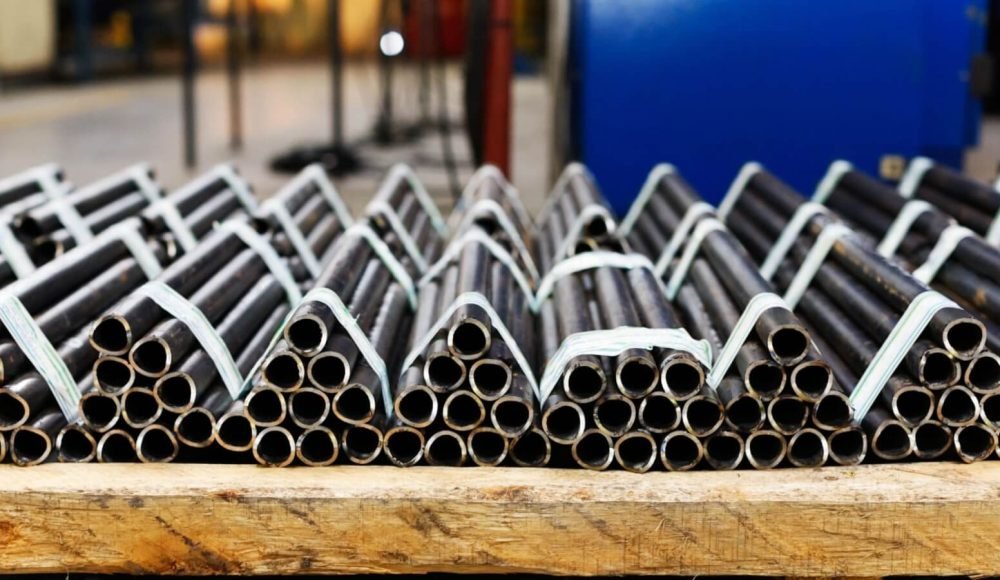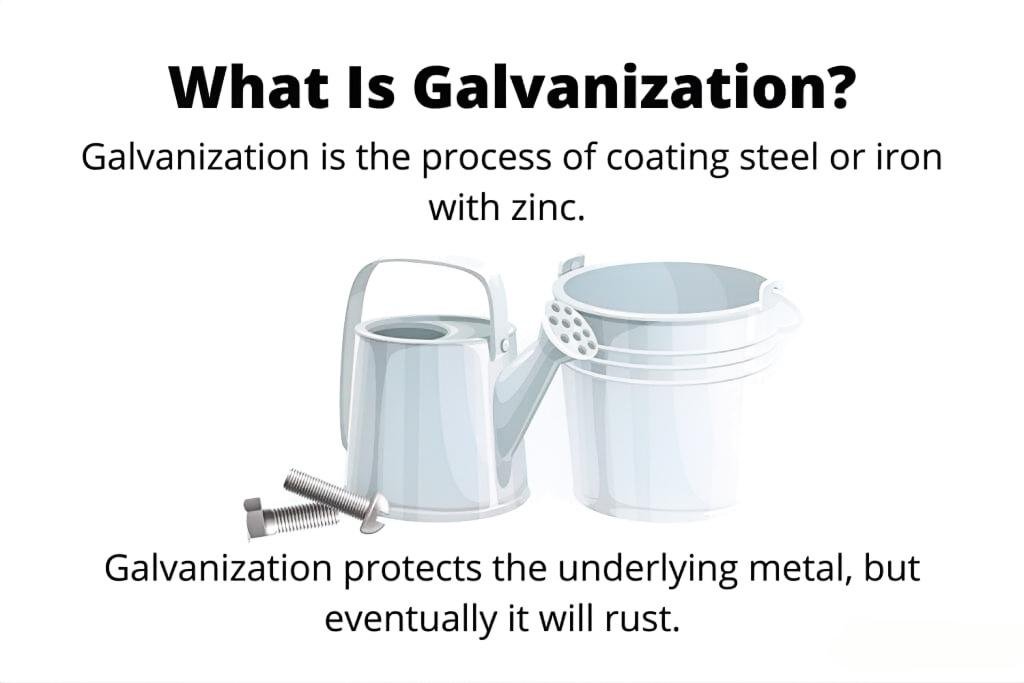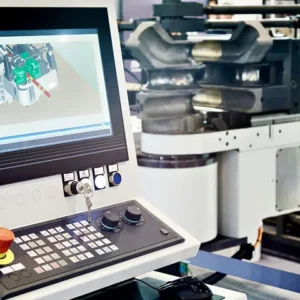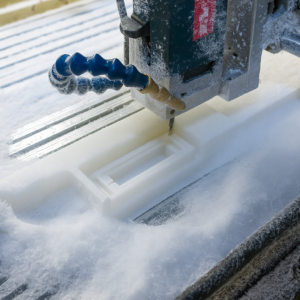Imagine a world where our bridges crumble early, cars rust within years, and pipelines leak due to unchecked corrosion. Galvanization is the unsung hero that prevents such degradation. This time-tested technique applies a protective zinc layer to steel or iron, dramatically extending the lifespan of metal structures and components.
As of 2023, the global market for galvanized steel stood at USD 98.80 billion and is projected to reach USD 166.09 billion by 2032, growing at a CAGR of 5.9%. Thanks to the sacrificial nature of zinc, which corrodes in place of steel, galvanization continues to be an essential process in construction, automotive, infrastructure, and manufacturing industries.
What is Galvanization?
Galvanization is the process of coating steel or iron with a layer of zinc to protect it from corrosion. This zinc layer serves two critical functions:
Barrier protection: Prevents oxygen, water, and contaminants from contacting the base metal.
Sacrificial protection: Zinc corrodes preferentially, protecting steel even if the coating is scratched.
The result is a robust, long-lasting material suitable for harsh environments and heavy-duty use.
Short History of Galvanization
The name “galvanization” originates from Luigi Galvani, an 18th-century Italian scientist who studied bioelectricity. The galvanization process as we know it was patented in 1836 by Stanislas Sorel in France. The UK followed closely, and by the mid-19th century, galvanized iron sheets became widespread in roofing and construction.
In fact, examples of early galvanization were found on 17th-century Indian armor, highlighting that the concept predates industrial applications. By 1850, zinc consumption for galvanizing had reached 10,000 tons annually, cementing its importance in metal protection.
How Does Galvanization Work?
Here’s how the process usually goes:
Step 1: Clean the Metal
Before anything else, the metal has to be super clean. That means removing all the grease, dirt, and rust. If it’s not clean, the zinc won’t stick properly.
Step 2: Acid Bath (Pickling)
Next, the metal gets a dip in a mild acid bath. This removes any leftover rust or scale and prepares the surface for coating.
Step 3: Rinse and Flux
After pickling, the metal is rinsed and treated with a special chemical called flux. This keeps the surface from oxidizing (rusting) before the zinc coating goes on.
Step 4: Dip in Molten Zinc
Now comes the main part: the metal is dipped into a bath of hot, melted zinc—about 450°C (850°F). When this happens, the zinc bonds with the steel, forming a protective layer that’s part of the metal itself.
Step 5: Cool Down and Inspect
Once coated, the metal is cooled down and checked to make sure the zinc layer is even and strong.
Chemical Process Behind Galvanization
Galvanization works due to galvanic corrosion, where zinc acts as the anode and corrodes instead of steel. When exposed to moisture, zinc forms zinc oxide and eventually zinc carbonate—a passive, protective layer that slows further corrosion. This self-healing effect is especially useful in outdoor or marine environments.
Benefits of Galvanization
1. Fights Off Rust Like a Pro
The #1 job of galvanization is to stop rust in its tracks. The zinc coating acts like armor—it keeps out water, oxygen, and anything else that causes corrosion. Even if the coating gets scratched, zinc still protects the steel underneath by corroding first. That’s what we call sacrificial protection.
2. Lasts for Decades
Galvanized metal doesn’t just last—it really lasts. In most environments, it can go 25 to 50 years without needing major repairs. In dry, mild areas, it can even last 70+ years. That means fewer replacements and less hassle over time.
3. Budget-Friendly
Compared to using stainless steel or other rust-resistant metals, galvanizing is much cheaper. You get great protection for a lower price. And since it lasts a long time, you save money in the long run too—no constant repainting or fixing needed.
4. Low Maintenance
Once it’s galvanized, you can pretty much forget about it. No need for regular painting or touch-ups. It just does its job quietly in the background.
5. Tough and Ready for Anything
Galvanized coatings are strong. They can handle rough handling during transport or construction without chipping or cracking. That makes them perfect for outdoor projects, building structures, fences, and more.
6. Full Coverage, Even on Edges and Corners
Unlike paint, which might miss tight spots or wear off quickly, galvanization coats the entire surface—including hard-to-reach corners, threads, and small holes. That means better all-around protection.
7. Eco-Friendly
Galvanized steel is 100% recyclable. Both the steel and the zinc can be reused, which makes it a smart choice for people and companies looking to reduce waste and be more sustainable.
How Galvanization Prevents Rust
1. It Blocks Out the Bad Stuff (Barrier Protection)
The first line of defense is simple: the zinc coating covers the steel like a raincoat. It keeps water, air, and salt from reaching the metal underneath. Since rust needs oxygen and moisture to form, no contact means no rust.
2. It Takes the Hit for the Steel (Sacrificial Protection)
But what if the coating gets scratched or chipped? That’s where the magic of zinc really kicks in. Zinc is more “active” than steel, meaning it wants to rust first. So, if a scratch exposes the bare metal, the zinc around it will still corrode first—not the steel. That’s called sacrificial protection.
It’s kind of like a brave friend stepping in to take the blame or damage so you don’t get hurt. The zinc sacrifices itself to protect the metal beneath.
3. It Builds a Bonus Layer Over Time
As zinc corrodes slowly, it forms a dull gray layer called zinc carbonate. This layer acts like a natural barrier, sealing the surface even more and slowing down future rust. So the older it gets, the more protected it becomes.
Types of Galvanization Methods
a. Hot-Dip Galvanizing
Steel is submerged in molten zinc.
Produces a thick, durable layer.
Common in infrastructure, bridges, and structural steel.
Pros: High corrosion resistance, cost-effective, strong adhesion.
Cons: Uneven coating, risk of hydrogen embrittlement in high-strength steels.
b. Pre-Galvanizing
Zinc-coated at the mill before forming into final shapes.
Ideal for steel sheets, pipes, and coils.
Pros: High-speed production, uniform coating.
Cons: Edges may be exposed after cutting or welding.
c. Electro-Galvanizing
Zinc applied via electroplating in an electrolyte solution.
Pros: Thin, smooth, aesthetic finish; good for auto bodies.
Cons: Lower corrosion resistance, higher cost for equipment.
d. Sherardizing (Thermal Diffusion Galvanizing)
Zinc powder diffused onto parts at high temperature (300–400°C).
Pros: Uniform coverage of complex parts; excellent adhesion.
Cons: Slower and costlier for large parts.
e. Galvannealing
Combines hot-dip galvanizing with heat treatment.
Produces a zinc-iron alloy layer with matte finish.
Pros: Paintable, weldable, peel-resistant.
Cons: Higher cost, reduced luster.
f. Mechanical Plating
Zinc particles are cold-welded onto the surface using tumbling with glass beads.
Pros: No heat; safe for high-strength fasteners.
Cons: Thin coating, limited to small parts.
g. Continuous Galvanizing
Fast, in-line process for steel coils and wire.
Pros: High throughput, consistent thickness.
Cons: Limited to flat or wire forms.
Tools Required for Galvanization
🔧 1. Zinc Bath (Hot and Ready)
This is a big tank filled with molten zinc—heated to around 450°C (850°F). It’s the heart of the hot-dip galvanizing process. Steel parts get dipped into this bath to form the protective zinc coating.
Think of it like a deep fryer for metal—but instead of oil, it’s full of melted zinc.
🧴 2. Pickling Tanks
These tanks are filled with mild acid solutions (like hydrochloric or sulfuric acid). Before coating, the steel needs a “deep clean” to remove rust, mill scale, and other grime that would stop the zinc from sticking.
🧪 3. Flux Tanks
After the acid bath, steel goes into a flux solution—usually zinc ammonium chloride. This stops the steel from oxidizing (rusting) before it hits the zinc bath and helps the zinc stick better.
🏗️ 4. Handling Equipment
Since metal parts can be big and heavy, factories use overhead cranes, hoists, or conveyor systems to move them through the process. This keeps everything running smoothly—and keeps workers safe.
🌡️ 5. Temperature and Thickness Tools
Thermometers check that the zinc bath is hot enough to bond with the steel.
Thickness gauges measure how thick the zinc layer is after coating, making sure it meets quality standards.
🧼 6. Cleaning Gear
Before any chemical steps, metal surfaces need to be free of grease or dirt. That means:
Degreasing solutions (like industrial soap)
Wire brushes or grinders for scrubbing tough spots
🧯 7. Safety Equipment (Very Important!)
Galvanizing uses heat and chemicals, so worker safety is a top priority. You’ll typically need:
Heat-resistant gloves and aprons
Face shields or safety goggles
Ventilation systems to remove fumes
Steel-toe boots for handling heavy parts
✅ 8. Final Inspection Tools
Once everything is coated and cooled, inspectors check the finished parts using:
Visual checks for drips or bare spots
Thickness measurements
Adhesion tests if needed
Key Parameters in Galvanization
Zinc temperature (typically 450°C)
Immersion time
Steel surface condition
Zinc purity and bath composition
Flux concentration
Withdrawal speed from zinc bath
Cooling rate
Steel grade and thickness
Environmental humidity
Air quality in the production zone
Materials That Can Be Galvanized
Steel (mild, high-strength)
Iron-based alloys
Copper alloys (in some thermal diffusion processes)
Pure iron
Note: Aluminum and stainless steel typically require different protective treatments like anodizing or passivation.
Common Applications
Construction: Beams, staircases, railings
Automotive: Body panels, frames
Agriculture: Grain bins, fencing
Infrastructure: Street lighting, guardrails
Plumbing: Galvanized pipes (40–50-year lifespan)
Marine: Coastal buildings, docks
Appliances & Electronics: Outer casings, panels
Disadvantages of Galvanization
⚠️ 1. Not Ideal for Super Strong Steels
If you’re working with high-strength steel, galvanizing can sometimes cause a problem called hydrogen embrittlement. That’s just a fancy way of saying the steel might become brittle and crack—especially under pressure. So, for very tough or critical parts, you may need to take extra precautions or use a different method.
🎯 2. Coating Might Not Be Perfectly Even
In some galvanizing methods (like hot-dip), the zinc coating can come out a bit uneven. You might see thicker spots, drips, or rough areas. For parts where looks really matter—or where precise measurements are important—this can be an issue.
✂️ 3. Cutting or Welding? You’ll Expose Bare Metal
Once the steel is galvanized, any cutting, drilling, or welding you do afterward will expose raw steel underneath. That area is no longer protected from rust—so you’ll need to go back and apply some kind of touch-up, like zinc-rich paint or spray.
🎨 4. It’s Not the Prettiest Finish
Galvanized steel usually has a dull gray or matte silver look. It’s not glossy or smooth like stainless steel. If you care a lot about how the surface looks—say, for interior design or decorative items—galvanized steel might not match your aesthetic.
☁️ 5. Watch Out for White Rust
Freshly galvanized metal can sometimes get a white, powdery coating if it’s stored in damp or humid places. This “white rust” doesn’t usually damage the metal, but it looks bad and can be a sign of improper storage.
📏 6. May Affect Size or Shape Slightly
Because zinc adds a coating layer, it can change the overall size or thickness of the part. This is usually a small difference, but for super precise parts, it might mess with the fit or tolerances.
Duration of the Process
🧼 1. Preparation (Cleaning, Pickling, Fluxing): 1–3 Hours
Before the metal even touches the zinc, it needs to be cleaned properly. That includes:
Degreasing (removing oil and dirt)
Pickling (removing rust with acid)
Fluxing (adding a coating to help the zinc stick)
Depending on how dirty or rusty the metal is, this part can take a couple of hours.
🛁 2. Zinc Dipping: A Few Seconds to a Few Minutes
The actual galvanizing part—dipping the metal into the molten zinc bath—is surprisingly quick. It usually only takes a few seconds to a couple of minutes, depending on the size and thickness of the part.
Thicker or more complex shapes might need a little more time to get fully coated.
❄️ 3. Cooling and Quenching: 10–30 Minutes
Once the metal comes out of the zinc bath, it needs to cool down so the coating can harden. Sometimes it’s cooled in air, other times it’s dropped into a water tank (quenching).
This step helps “lock in” the coating and speeds up the process.
✅ 4. Inspection and Touch-Ups: 10–60 Minutes
After everything cools, the galvanized parts are checked for quality. Workers look for bare spots, drips, or areas that need a touch-up. This can take a bit of time, especially for large or complex pieces.
🕒 So, What’s the Total Time?
Small, simple parts: Done in just a few hours.
Larger or more detailed parts: Could take a full day, depending on the workflow and setup.
High-volume production lines (like continuous galvanizing for steel coils) can run non-stop and process thousands of feet of material per hour.
Galvanized Steel Lifespan
Average: 25–50 years
Mild environments: Up to 75 years
Marine/industrial: 10–30 years
Influenced by:
Coating class (e.g., G90, G185)
Environment (urban vs rural)
Maintenance (topcoats, inspections)
Safety Measures
PPE: Gloves, face shields, aprons
Ventilation: Essential to remove zinc fumes
Proper chemical handling
Welding precautions: Remove zinc around joints
Training: For all personnel
Temperature monitoring and controls
Common Defects
Bare spots: From poor cleaning or fluxing
Zinc drips/runs: From improper withdrawal speed
Warping: Due to uneven heating
White rust: Caused by humid storage
Rough coatings or pinholes: From zinc impurities
Weld slag residue: Prevents proper bonding
Galvanized Steel vs Stainless Steel
| Feature | Galvanized Steel | Stainless Steel |
| Cost | Lower | Higher |
| Corrosion Resistance | Moderate (coating-dependent) | High (inherent alloy protection) |
| Durability | Decades in mild environments | Long-lasting even in harsh settings |
| Appearance | Matte/spangled | Bright, smooth |
| Paintability | Limited (requires prep) | Excellent |
| Applications | Structural, automotive, outdoor | Marine, medical, food, chemical |
How to Identify Galvanized Steel
Visual: Crystal-like “spangle” pattern
Rust appearance: White/gray corrosion (zinc oxide)
Magnet test: Magnetic (unlike some stainless steels)
Surface: Slightly rough or mottled finish
Chemical & Physical Properties
Corrosion resistance: Excellent for moderate environments
Magnetic: Retains steel’s magnetic properties
Thermal resistance: Stable until zinc’s melting point (~419°C)
Mechanical strength: Base metal retained; surface hardened by coating
Conclusion
Galvanization is an indispensable technique in modern manufacturing and infrastructure. It offers a practical, cost-effective solution to corrosion while preserving structural integrity for decades. Whether you’re designing skyscrapers, building vehicles, or fabricating electronics, choosing the right galvanization method ensures your product stands the test of time.
Read More:





